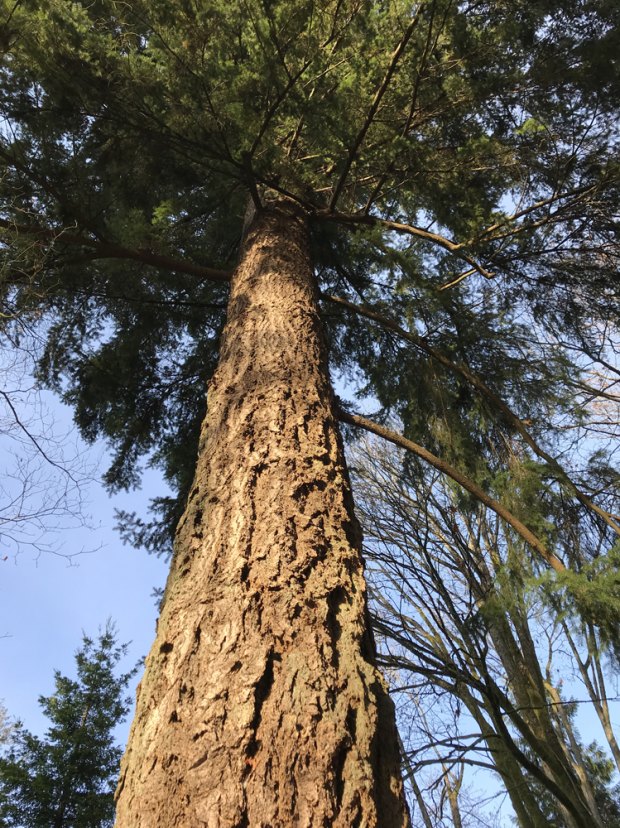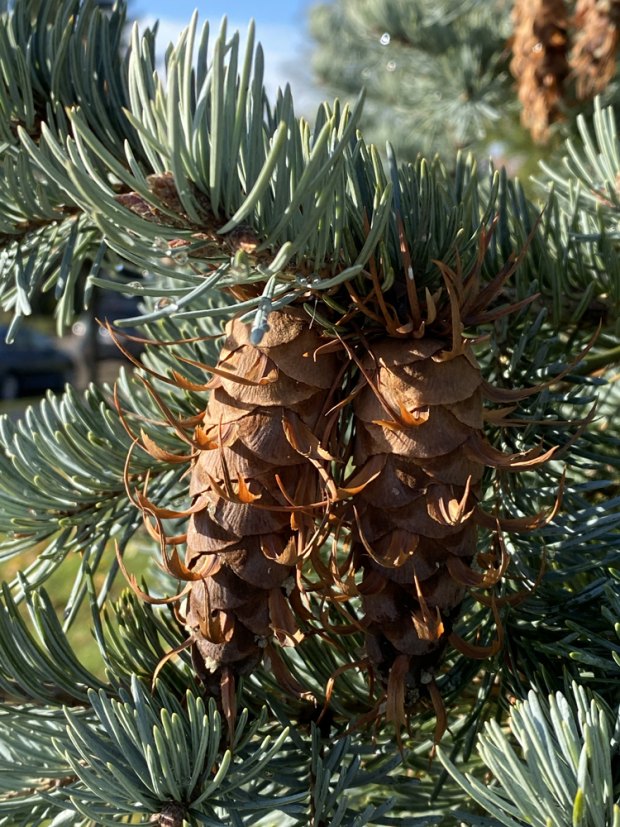
I think of the First Nations myth about a Douglas-fir cone’s bracts resembling the rear end of a hiding mouse. The grooves on Douglas-fir’s bark are deep enough to afford a tiny mammal a place to hide from a forest fire. Indeed this thick, corky covering protects Douglas-firs from fire, while also benefitting their fallen cones by providing a clearing in which they can germinate.
How thrilled the early explorers who came to our West Coast of North America must have been to discover an evergreen so tall, so straight, and so true. In 1792, Archibald Menzies was hired as the surgeon, botanist, and naturalist on Captain George Vancouver’s voyage to North America on HMS Discovery.
Born in Perthshire, Scotland, Menzies had trained as a botanist at Edinburgh University. His role was to preserve such new plants as were worthy of a place among “His Majesty’s very valuable collection of exotics at Kew.”2 Douglas-fir (Pseudotsuga menziesii) gets its species name from Archibald Menzies.
Archibald Menzies briefly mentored a young man, David Douglas, also from Perthshire in Scotland. Douglas trained at Glasgow University as a botanist and gardener. He explored the Scottish highlands and then North America in the 1820s. He was the botanist responsible for encouraging the commercial use of the Douglas-fir, writing about it in his journal: “The wood may be found very useful for a variety of domestic purposes: the young slender ones exceedingly well adapted for making ladders and scaffold poles, not being liable to cast; the larger timber for more important purposes; while at the same time the rosin may be found deserving attention.”3
In 1834 in Hawaii, David Douglas died a mysterious and brutal death. He was only 35. He was last seen at the hut of Englishman Edward “Ned” Gurney, a bullock hunter and escaped convict. Douglas apparently fell into a pit trap where he was crushed by a wild Hawaiian bull that fell into the same trap. However, Gurney was also suspected in Douglas’s death, as Douglas was said to have been carrying more money than Gurney subsequently delivered with the body.4
Douglas-fir, this evergreen that is native to North America’s West Coast, China, and Japan, celebrates both Menzies and Douglas: Menzies in the specific epithet of its Latin name of Pseudotsuga menziesii; Douglas in its common name of Douglas-fir.
We owe the usage of fir in this tree’s common name to the desire of those who colonized our West Coast to simplify tree names to ones they recognized. And they were familiar with firs in their native lands. But Douglas-fir is not a member of the fir genus of Abies; hence the hyphenation.
Sticking to the topic of this tree’s binomial nomenclature—its two-part Latin name—Douglas-fir went through a series of names from when Archibald Menzies first discovered its uniqueness to decades after Douglas recognized its potential. The route to this Latin name was circuitous, but it was finally pinned down in 1867 by the French botanist and conifer expert, Élie-Abel Carrière, who first created the genus Tsuga, meaning “hemlock” and then created the genus Pseudotsuga, meaning “false hemlock.”5 He recognized some of the similarities between Douglas-firs and hemlocks, such as flat needles and seed cones that stay whole when they fall to the ground (unlike the seed cones of every true fir tree in the genus, Abies, which disintegrate as they mature, a cone scale at a time).
For a while after 1867, Douglas-fir was known as Pseudotsuga taxifolia, recognizing how Douglas-fir needles are similar to the needles of a yew tree (Taxus genus). But Pseudotsuga menziesii was deemed the original name and thereby became the species’ legitimate Latin name.6
Sometimes, to differentiate it from the other geographic race growing in North America, the coastal Douglas-fir is identified as Pseudotsuga menziesii var. menziesii.
Walking through UBC campus one day, I came across a couple of young evergreens that were blue in colour. The cones were familiar, almost a caricature of the Douglas-fir cone I knew, because the bracts flared out from the cone. I finally realized these were Rocky Mountain Douglas-fir trees with the Latin name, Pseudotsuga menziesii var. glauca, where glauca is Latin for the adjective glaucous, meaning both bluish-white in colour and covered with a waxy coating that rubs off. 
This race of Douglas-fir grows more slowly to half the height and girth of its coastal cousin.
Text and photos Nina S., Vancouver Master Gardeners
2 Archibald Menzies, Menzies’ Journal of Vancouver’s Voyage: April to October 1972. Edited by C.F. Newcombe, MD. Victoria, BC: Legislative Assembly of British Columbia, 1923. open.library.ubc.ca/collections/bcbooks/items/1.0226118 and archive.org/details/menziesjournalof1792menz/
3 David Douglas, Journal Kept by David Douglas, 1823-1827. London: William, Wesley & Son, 1914; Biodiversity Heritage Library, 2006. www.biodiversitylibrary.org/item/59487#page/5/mode/1up.
4 John Davies, Douglas of the Forests: The North American Journals of David Douglas. Seattle: University of Washington Press, 1980.